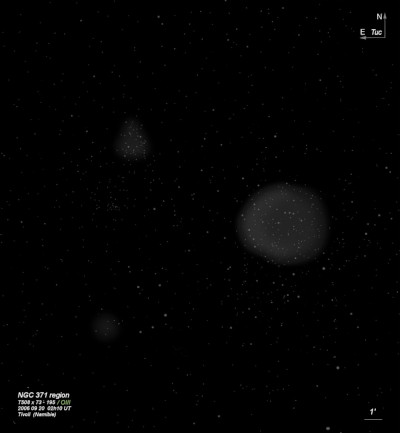
10x30mm and 15x50mm IS binoculars: easily visible along with NGC 346.
James Dunlop discovered NGC 371 = D 31 = h2376 on 1 Aug 1826 with his 9" reflector at Parramatta and recorded "a pretty large unequally bright nebula, about 5' diameter, round figure, resolvable into stars of mixt magnitudes." He made 5 observations and his published position is 8' too far south.
John Herschel made 5 observations beginning on 11 Apr 1834, recording "cluster, 6th class; faint, round, 10' diameter, stars 15..18th mag." The next observation was logged as "vF, L, p rich cluster, 6th class. Stars 14..15th mag." On a third sweep he noted it as "a F, L, p compressed cl of 6th class. 10' diameter. gbM; stars 12..16th mag - in some parts almost nebulous." The fourth observation was recorded as a "cluster 6th class; stars 12..15th mag, a few = 10th mag and one of 9th mag; much compressed in the middle; fills field and has loose straggling lines and crooks branching off." The final sweep was recorded as "F, L, cl; little compressed; gbM; 7' diam; resolved into stars 14..16th mag." Herschel noted that this may be Dunlop 31.
400/500mm - 18" (7/6/02 - Magellan Observatory, Australia): at 171x and UHC filter, NGC 371 is a fairly bright, prominent, round SMC nebulous cluster, up to 6' in diameter with a fairly well-defined edge. The haze has a pretty consistent high surface brightness and seems suspended in a large, scattered cluster or star cloud (Hodge Association 53). A 5' string of four mag 10-11 stars oriented NW-SE is superimposed on the glow (one is mag 13.0 WR star SMC AB 7) as well as a number of fainter stars. SMC AB 6, another mag 12 WR binary, is at the south end. This is an excellent low power field with the striking HII region NGC 346 22' WSW and NGC 395/IC 1624 8'-10' NE.
Notes by Steve Gottlieb